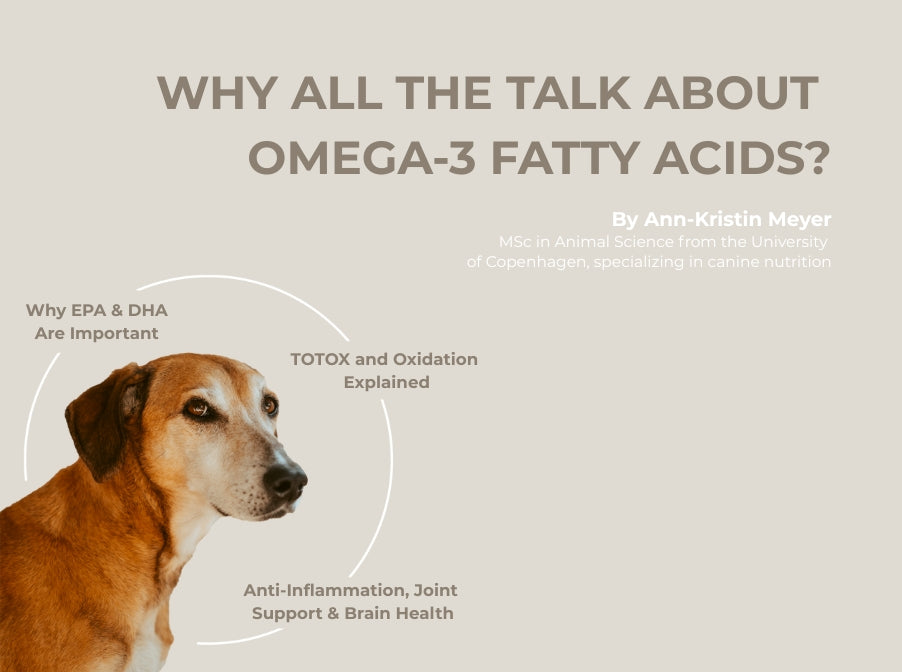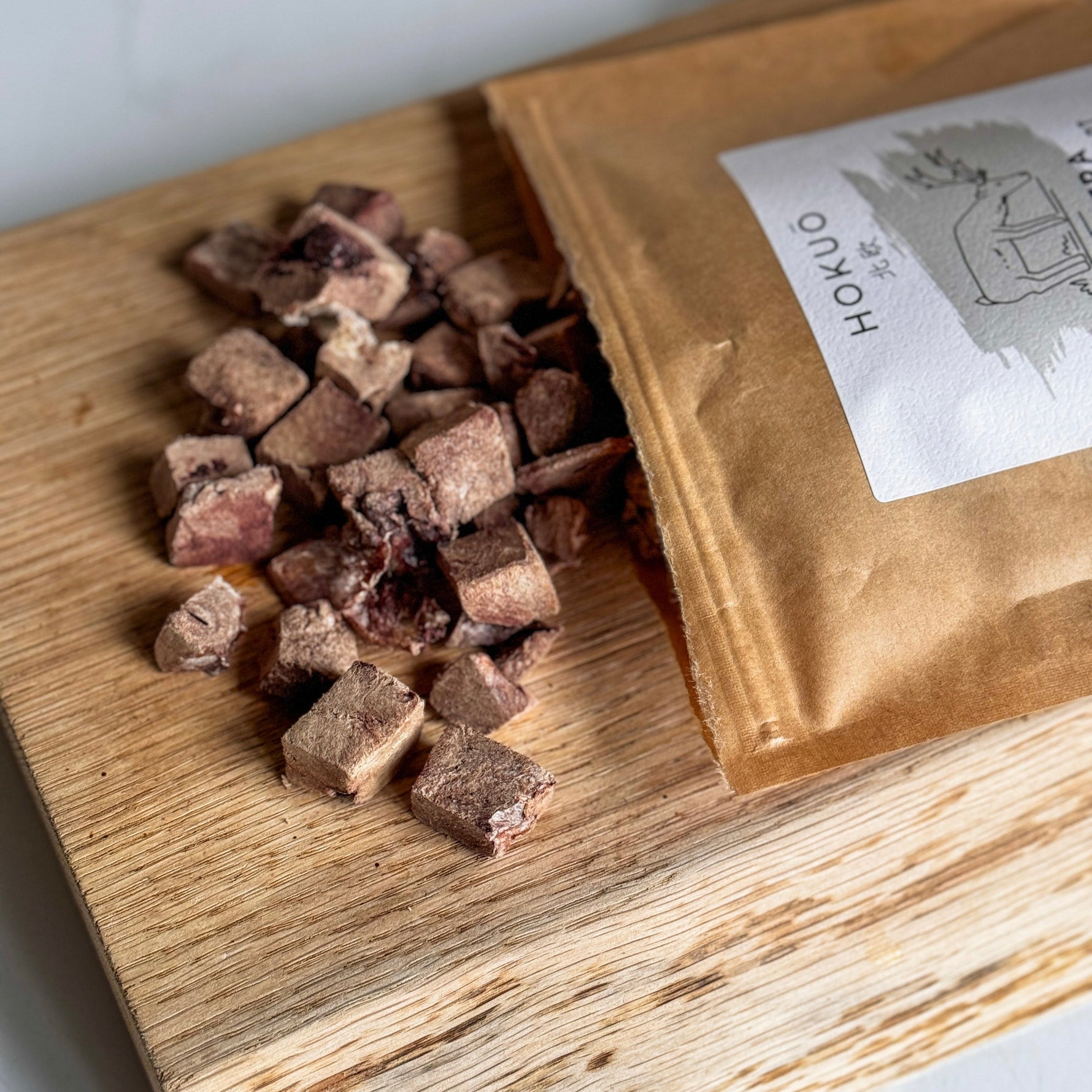The Hokuō® Journal

Kollagen för hundar – mer än bara en proteinkälla?
av Ann-Kristin Meyer / HundeFoderNørden på okt. 20 2025
Kollagen är mycket mer än bara ett strukturellt protein – det spelar en avgörande roll för din hunds övergripande hälsa. Den här artikeln utforskar hur olika kollagentyper (I, II och III) stödjer starka leder, flexibla senor, en frisk hud och till och med en robust tarmbarriär. Med stöd i vetenskaplig forskning förklarar den skillnaderna mellan hydrolyserade kollagenpeptider och icke-denaturerat UC-II®, hur de påverkar immunsystemet och vad nyare studier visar om kollagenets potentiella fördelar för hundar med artros. Artikeln tar också upp benbuljong som en naturlig kollagenkälla och sammanfattar praktiska insikter för hundägare som vill främja ledhälsa och rörlighet genom evidensbaserad nutrition.

A New Path of Food Topper for Dogs & Cats
av Ann-Kristin Meyer / HundeFoderNørden på juli 31 2025
When your dog or cat refuses to eat
Few things are more frustrating than a dog that won’t touch its food. While some dogs are adventurous, many grow attached to the smell, texture, and flavor of what they’re used to. A well-meaning switch to healthier food can easily turn into mealtime battles. That’s why many pet owners resort to liver pâté or squeeze tubes — quick fixes that seem to work. But here’s the catch: these are highly processed, often packed with additives, and not ideal as daily solutions. That’s where a natural, nutrient-supporting cat & dog food topper like Hokuō® Reindeer & Duck comes in.
The problem with highly processed food
Most liver pâté and squeeze pastes on the market are classified as ultra-processed foods. From studies in both humans and animals, we know that ultra-processed diets negatively affect overall health—especially gut health and the delicate microbiota that live in the intestines of both humans, dogs, and cats. These microbiota play a key role in your pet’s well-being but are easily disrupted by synthetic additives.
Additionally, liver pâté contains high amounts of vitamin A. As a fat-soluble vitamin, it’s stored in the body and can easily be overdosed. Many pet owners use dried liver as treats—often the only thing their picky pet will accept. When liver pâté is also added to meals, it’s easy to reach excess levels of vitamin A, which can lead to joint and skin issues.
Hokuō®’s answer: A healthy and tasty topper
So, what do you do when your dog or cat will only eat if the food is "upgraded" with liver pâté or paste? That was the question that inspired the development of Hokuō® Reindeer & Duck Topping . Christian wanted to create a topper that was both incredibly tasty and health-promoting—something safe to use daily without risking nutritional imbalance. On the contrary, it should support the animal’s health and well-being.
That’s when Christian reached out to me. He had already crafted a well-thought-out sauce and wanted help adjusting the recipe—and the production method—so that it could become a daily part of a pet’s meal plan while still offering real nutritional value.
Benefits of Hokuō® Reindeer & Duck Topping
The result is a topper with a variety of nutritional benefits for dogs and cats who get to enjoy it:
Collagen from cartilage : Supports the gut lining and may help prevent digestive disorders.
Vegetable fibers : Feed the beneficial gut bacteria, contributing to better digestion and general well-being.
Small amounts of liver and heart : Just enough to create a rich taste and add nutrients—without risking vitamin A overload.
Explore Now
"Especially this last detail shows how far Christian goes to get the most out of every product—and as a nutrition expert, I deeply respect that!"
- Ann-Kristin Meyer // HundeFoderNørden
Gentle processing for maximum nutrition
Since the sauce is a processed product, it was crucial to design the production in a way that preserves as many nutrients as possible—while avoiding synthetic additives.
This is achieved by:
Using low processing temperatures and rapid cooling afterward.
Cooking animal and plant ingredients separately to minimize the Maillard reaction , which can reduce protein digestibility.
Why is this important? Because the vegetables in the sauce don’t just provide fiber—they also contain starch and sugar. When protein-rich ingredients like liver, heart, and cartilage are cooked together with sugar- or starch-rich ingredients, the Maillard reaction kicks in. This reaction makes it harder for your pet to absorb the protein in the food.
In other words: protein digestibility drops, and your pet gets less nutritional value from the meal.
By cooking the animal and vegetable ingredients separately, and only mixing them after cooking, this reaction is minimized—so your pet can benefit from more of the nutrition in every bite. Once again, this shows how far Christian goes to get the very best out of his products—and that’s something I truly admire!
The Author: Ann-Kristin Meyer
MSc in Animal Science from the University of Copenhagen, specializing in canine nutrition, Owner of HundeFoderNørden
Why Omega-3 Fatty Acids Matter for Your Dog’s Health
Read more
3 Easy Summer Lickmat Recipes for Cats & Dogs
Read more
Bone Broth for Dogs and Cats: Liquid vs Dehydrated?
Read more

Varför omega-3-fettsyror är viktiga för din hunds hälsa
av Ann-Kristin Meyer / HundeFoderNørden på juli 22 2025
Varför pratar alla om omega-3-fettsyror?
Om du har hund har du förmodligen varit med i minst en diskussion om hundfoder. Och ganska ofta landar samtalet på ett särskilt näringsämne: omega-3-fettsyror. Men varför är det så mycket fokus på omega-3 i hundmat? Vad gör omega-3-fettsyror så speciella jämfört med andra näringsämnen? Och vad ska du vara uppmärksam på när du väljer omega-3-tillskott till din hund? Det är precis det du får veta här nedan.
Innehållsförteckning
Vad är omega-3-fettsyror? Vilka omega-3-fettsyror finns det? De viktiga fysiologiska funktionerna hos EPA och DHA Det slutar inte där Det här behöver du veta när du väljer och förvarar omega-3-tillskott till din hund Nästa gång du är i hundparken …
Vad är omega-3-fettsyror?
Omega-3-fettsyror är fleromättade fetter som är avgörande för en rad fysiologiska processer. De tillhör gruppen långkedjiga fettsyror, vilket gör dem särskilt reaktiva och biologiskt aktiva. Det är viktigt att ha i åtanke när du väljer omega-3-tillskott – och när du ska veta hur de ska förvaras.
Eftersom hundar inte kan producera tillräckliga mängder omega-3-fettsyror själva måste de tillföras via fodret. Det gör omega-3 till essentiella näringsämnen för hundar.
Se produkt
Vilka omega-3-fettsyror finns det?
De omega-3-fettsyror som oftast diskuteras inom hundnutrition är alfalinolensyra (ALA), eikosapentaensyra (EPA) och dokosahexaensyra (DHA). Även om alla tre är omega-3 så är de inte likvärdiga när det kommer till att utfodra din hund. ALA finns i många växtbaserade oljor som linfröolja, hampaolja och chiaolja, och kan i kroppen omvandlas till EPA och DHA. Hundar är dock inte särskilt effektiva på att omvandla ALA – bara cirka 5–10 % blir EPA, och mindre än 1 % blir DHA.
Det innebär att vegetabiliska oljor – med ett undantag – inte kan ersätta ingredienser som är rika på EPA och DHA. Undantaget är algolja, som är den enda växtbaserade oljan som är rik på både EPA och DHA. Alla andra betydande källor till EPA och DHA kommer från marina källor som fisk, musslor, krill och alger.
Varför EPA och DHA är så viktiga
Du kanske tänker: ”Varför kan jag inte bara använda en bra växtolja som är rik på ALA?” Det är ofta både enklare och billigare. Svaret ligger i det breda spektrum av fysiologiska effekter som EPA och DHA ger – men som ALA inte ger.
Även om ALA på papperet räknas som en essentiell fettsyra är dess främsta funktion att fungera som föregångare till EPA och DHA. Och eftersom hundar knappt kan göra den omvandlingen är ALA inte fysiologiskt tillräcklig. Den kan inte täcka hundens verkliga omega-3-behov, särskilt inte vid inflammation, dräktighet och digivning, hjärnans utveckling hos valpar eller problem med hud och päls.
Här kommer haket: om du siktar på en låg omega-6 till omega-3-kvot (med god anledning, vilket vi återkommer till senare) kan du inte bara förlita dig på siffrorna som anges av foderproducenten. En kvot på 4:1 eller 3:1 kan se jättebra ut – men om omega-3-delen främst kommer från ALA får fodret inte den effekt du är ute efter.
Det positiva? Du behöver inte oroa dig för om din hund får tillräckligt med ALA. Du kan fokusera helt på EPA och DHA.
Wild-caught Baltic Sprat Graphic © Hokuō®
New Zealand Green-Lipped Mussel Graphic © Hokuō®
De viktiga fysiologiska funktionerna hos EPA och DHA
Anti-inflammatoriska egenskaper
En nyckelorsak är EPAs anti-inflammatoriska effekt. Det är här förhållandet mellan omega-6 och omega-3 blir mycket relevant. Arakidonsyra (AA), en omega-6-fettsyra, och EPA bearbetas båda i kroppen via samma enzymvägar: cyklooxygenas (COX) och lipoxygenas (LOX). Dessa enzymer omvandlar fettsyrorna till eikosanoider, hormonliknande budbärare som hjälper till att reglera inflammation.
När AA bryts ned bildas främst eikosanoider som främjar inflammation, smärta, feber och rekrytering av vita blodkroppar – något som är nödvändigt vid en akut infektion. Men för mycket AA-aktivitet kan leda till kronisk inflammation.
EPA, däremot, omvandlas till eikosanoider som motverkar inflammation. Eftersom EPA och AA konkurrerar om samma enzymer hjälper en högre EPA-koncentration i blodet till att dämpa hundens inflammatoriska svar.
EPA och DHA är också föregångare till specifika signalmolekyler som aktivt löser upp inflammation och stödjer vävnadsläkning.
Roll vid ledbesvär och artros
Denna anti-inflammatoriska verkan är också anledningen till att omega-3 spelar en så viktig roll vid hantering av artros. Artros är en låggradig, kronisk inflammation i lederna. De anti-inflammatoriska egenskaperna hos EPA och DHA kan minska ledsvullnad, smärta och stelhet.
Studier har visat att hundar med artros som fått tillskott av marina omega-3-fettsyror gick bättre och längre, visade mindre smärtbeteende och behövde färre NSAID-läkemedel. Det finns också potential för EPA och DHA att bromsa utvecklingen av artros genom att minska nedbrytningen av ledbrosk.
Hjärnans utveckling och kognitiv funktion
Marina omega-3 är inte bara bra mot inflammation – de är också avgörande för hjärnhälsan. Särskilt DHA är viktigt för nervsystemets utveckling hos valpar och för att bevara kognitiv funktion hos äldre hundar. Det är inte så konstigt, med tanke på att DHA är en viktig strukturell komponent och den mest förekommande fettsyran i hundens hjärna.
Flera studier tyder på att valpar som fick DHA-tillskott efter avvänjning lärde sig snabbare, visade bättre kognition och hade bättre minne än de som inte fick DHA. Detsamma gäller valpar vars mödrar fick DHA under dräktigheten – de presterade avsevärt bättre i beteende- och kognitionstester.
Det slutar inte där
Och nej, fördelarna slutar inte där. EPA och DHA stöttar också hudbarriären och bidrar till bättre hud- och pälskvalitet. Även hjärt-kärlsystemet gynnas av marina omega-3, och DHA har visat sig förbättra inte bara kognition utan också synutvecklingen hos valpar.
En nyare observationsstudie tyder till och med på att marina omega-3 i valpfoder kan minska risken för epilepsi senare i livet.
Det här behöver du veta när du väljer och förvarar omega-3-tillskott till din hund
Välj fiskoljor eller andra omega-3-tillskott från hållbara källor som är testade och renade från föroreningar som tungmetaller och PCB:er.
Omega-3-fettsyror är mycket känsliga för oxidation (kom ihåg: de är mycket reaktiva och biologiskt aktiva). Oxiderade fetter är inte bara verkningslösa – de kan faktiskt skada hundens vävnader genom att bilda fria radikaler. Totox-värdet (total oxidation) är ett mått på hur oxiderad en olja är. Ju lägre Totox-värde, desto mindre oxiderad är oljan. Sikta på ett Totox-värde under 5. Tyvärr anges inte alltid detta värde av tillverkaren.
Förvara omega-3-tillskott på ett sätt som skyddar dem från ljus, värme och syre. Förvara dem i kylskåp och använd dem inom några veckor.
Du kan också täcka en del av din hunds omega-3-behov genom att ge fet fisk regelbundet i fodret. Beroende på hur mycket fisk som ingår kan ytterligare tillskott vara onödigt. Många kompletta hundfoder innehåller också marina omega-3 – men precis som tillskott är de känsliga för oxidation. När fodret väl hamnar i hundens matskål kan omega-3-fettsyrorna därför ha tappat mycket av sin effekt.
Det beror på många faktorer: kvaliteten på omega-3-källan, hur fodret är förpackat, hur länge det har lagrats hos tillverkaren, hos återförsäljaren och hos dig – och till och med storleken på fodersäcken, som påverkar hur länge fodret utsätts för syre.
Se produkt
Se produkt
Nästa gång du är i hundparken …
Nästa gång du är i hundparken och samtalet glider in på hundfoder och omega-3 är chansen stor att du vet mer än de flesta – och kanske till och med kan bjuda på ett tips eller två.
Källor:
Antonelli, C. et al. (2023). Effects of docosahexaenoic acid dietary supplementation on cognitive learning and memory in healthy puppies. Animals, 13(20), 3261.
Bauer, J. E. (2011). Enhancing canine cognition with omega-3 fatty acids. Nestlé Purina Nutrition Forum.
Bauer, J. E. (2006). Therapeutic use of fish oils in companion animals. Journal of the American Veterinary Medical Association, 229(11), 1761–1764.
Bauer, J. E. et al. (2018). Evaluation of enrichment of diets with omega-3 fatty acids and effects on plasma fatty acid profiles in dogs and cats. Journal of the American Veterinary Medical Association, 252(12), 1470–1478.
Calder, P. C. (2017). Omega-3 fatty acids and inflammatory processes: from molecules to man. Biochemical Society Transactions, 45(5), 1105–1115.
Carlisle C. et al. (2024). The Effects of Omega-3 Supplementation on the Omega-3 Index and Quality of Life and Pain Scores in Dogs. Animals, 14(21):3108.
Freeman, L. M. et al. (2010). The role of nutritional supplements in cardiac disease. Journal of Veterinary Cardiology, 12(3), 149–155.
Fritsche, K. L. et al. (2010). Omega-3 polyunsaturated fatty acids and immune regulation. British Journal of Nutrition, 104(Suppl 2), S1–S9.
Heinemann, K. M. et al. (2005). Docosahexaenoic acid supplementation during pregnancy and lactation affects visual, cognitive, and behavioral development in dogs. Journal of Nutrition, 135(8), 1960S–1964S.
Hemida M. et al. (2023). Assessing the association between supplemented puppyhood dietary fat sources and owner-reported epilepsy in adulthood, among Finnish companion dogs. Frontiers in Veterinary Science, 10:1227437.
Lenox, C. E. & Bauer, J. E. (2013). Potential adverse effects of omega-3 fatty acids in dogs and cats. Journal of Veterinary Internal Medicine, 27(2), 217–226.
Logas, D. & Kunkle, G. A. (1994). Clinical response of canine pruritus to dietary supplementation with omega-3 and omega-6 fatty acids. Veterinary Dermatology, 5(3), 99–104.
Packer, R. M. A. et al. (2023). Fish-based fat sources in puppyhood are associated with reduced risk of idiopathic epilepsy in adult dogs. Frontiers in Veterinary Science, 10, 1202192.
Roush, J. K. et al. (2010). Evaluation of the effects of dietary supplementation with fish oil omega-3 fatty acids on weight bearing in dogs with osteoarthritis. JAVMA, 236(1), 67–73.
Shahidi, F. & Zhong, Y. (2010). Lipid oxidation and improving the oxidative stability. Chemical Society Reviews, 39(11), 4067–4079.
Zicker, S. C. et al. (2012). Cognitive and behavioral effects of dietary supplementation with fish oil in senior dogs. The Veterinary Journal, 192(3), 426–431.
Zicker, S. C. et al. (2012). Evaluation of cognitive function in puppies fed dietary docosahexaenoic acid. Journal of the American Veterinary Medical Association, 240(8), 935–941.
Författare: Ann-Kristin Meyer
MSc i Animal Science vid Köpenhamns universitet, med inriktning mot hundnutrition, ägare av HundefoderNørden
3 enkla sommarsrecept till slickmattor för katter och hundar
Läs mer
Benbuljong till hundar och katter: flytande eller torkad?
Läs mer
Hur tillverkas frystorkade godbitar för katter och hundar?
Läs mer

Lite är bättre än ingenting: en guide till färska ingredienser i din hunds mat
av Ann-Kristin Meyer / HundeFoderNørden på jan. 28 2025
En guide till färska ingredienser i din hunds foder.- Skriven av Ann-Kristin Meyer, ägare av HundeFoderNørden
Översikt
Processad mat och livsstilssjukdomar Vad är processad mat Likheter mellan människor och hundar i näring Hur du kan inkludera färska ingredienser i din hunds kost Rekommenderad fördelning av ingredienser Hur mycket färsk mat bör ingå
Processad mat och livsstilssjukdomar
I människovärlden råder det inte längre något tvivel: ett högt intag av kraftigt processad mat i kombination med att man undviker färska, oprocessade livsmedel i kosten är kopplat till en ökad förekomst av olika livsstilssjukdomar, såsom övervikt, cancer, diabetes och depression. Under de senaste åren har det också börjat hända saker inom forskningen kring hundnutrition. Fler och fler studier tyder på att färsk, oprocessad mat har en positiv effekt på hundens hälsa och välbefinnande, medan kraftigt processat foder verkar påverka hundens hälsa negativt.
Vad är processad mat?
Kraftigt processad mat, eller som det kallas på engelska, ”ultra-processed food”, definieras som rätter som innehåller ingredienser som du normalt inte skulle använda i ett vanligt kök. Dit hör konserveringsmedel, smakförstärkare, färgämnen, sötningsmedel och emulgeringsmedel. Dessa ämnen tillsätts i kraftigt processad mat för att efterlikna kvaliteten och den sensoriska upplevelsen av minimalt processad mat. Detta är definitionen av kraftigt processad MAT. Många av de tillsatser som nämns i denna definition återfinns dock också i kraftigt processat hundfoder. Och den absoluta majoriteten av det hundfoder som finns på butikshyllorna, i djuraffärer eller på veterinärkliniker är kraftigt processat foder.
Processad mats effekt på tarmens mikrobiota
Många olika näringsstudier inom humanområdet tyder på att kraftigt processad mat påverkar tarmens mikrobiota negativt. Tarmmikrobiotan är den totala mängden mikroorganismer som lever i människans tarm. Dit räknas bakterier, svampar och virus, men bakterierna utgör den största andelen och är också de mest studerade bland tarmens invånare. Även om tarmmikrobiotan inte liknar våra klassiska organ, såsom lever, njurar och mjälte, beter den sig på ett liknande sätt och kan därför klassificeras som ett organ – ett mycket avancerat sådant dessutom!
Foto: Rozanne Willems for Hokuō®
Likheter mellan människor och hundar i näring
Precis som människor drabbas allt fler hundar av de ovan nämnda livsstilssjukdomarna. Och precis som vi får många hundar en stor del av sin dagliga kost i form av kraftigt processad mat. Många hundar utfodras till och med uteslutande med kraftigt processat foder. Att se samma utveckling hos hundar som hos människor är därför inte förvånande. Olika studier visar att hundens tarmmikrobiota reagerar på näringsfaktorer på ett sätt som är jämförbart med hur människans tarmmikrobiota reagerar.
Fördelar med färska ingredienser
Även om många fortfarande hävdar att det inte finns några studier som visar att färsk, minimalt processad mat, såsom BARF (råfoder) eller hemlagad mat, är hälsosammare för hundar än kraftigt processat foder, stämmer detta helt enkelt inte. Särskilt under de senaste åren har flera vetenskapligt granskade studier publicerats som drar slutsatsen att minimalt processad mat har en hälsofrämjande effekt, medan kraftigt processad mat har en skadlig effekt på hälsan.
Hur du kan inkludera färska ingredienser i din hunds kost
Ingredienser som bör ingå i din hunds färska mat är kött, organ, köttiga ben, ägg, fet fisk, grönsaker och eventuellt bär. Kött bör helst vara muskelkött eftersom det har mycket hög proteinkvalitet. Det kan ges rått eller tillagat, t.ex. kokt i en gryta med lite vatten. Om köttet tillagas är det en bra idé att också ge kokvattnet som en del av portionen, eftersom vissa näringsämnen läcker ut i vattnet under tillagningen.
"Kom ihåg, lite är bättre än ingenting, så även små steg kan göra stor skillnad för din hunds hälsa.”
Rekommenderad fördelning av ingredienser
Fördelningen mellan de olika ingrediensgrupperna kan se ut så här:
Två delar kött
Två delar köttiga ben
En del inälvor
En del fisk
En del ägg
Dessutom lite grönsaker och eventuellt bär
Det är inte nödvändigt att alla ingredienser ingår varje dag. Till exempel kan du ge kött två dagar i veckan, köttiga ben två andra dagar och organ, fisk och ägg de återstående dagarna. Grönsaker kan läggas till som topping varannan dag.
Foto: Rozanne Willems for Hokuō®
Köp nu
Köp nu
Köp nu
Hur mycket färsk mat bör ingå?
Forskning tyder på att cirka 20–25 % färsk mat krävs för att uppnå en hälsofrämjande effekt. För att säkerställa att hunden inte hamnar i energibrist (kaloriunderskott) är det viktigt att veta hur mycket energi (kalorier) hunden får i sig via industriellt producerat foder. Detta kan fastställas genom att mäta upp hundens dagliga fodergiva och kontrollera förpackningen eller tillverkarens webbplats för att se kaloriinnehållet.
Sammanfattning
Om du följer ovanstående riktlinjer och varierar ingredienserna väl är risken för näringsbrist mycket låg, även om du ersätter 30–40 % av hundens processade foder med färska ingredienser. Kom ihåg, lite är bättre än ingenting – även små steg kan göra stor skillnad för din hunds hälsa.
Källor:
Coelho et al. 2018: Similarity of the dog and human gut microbiomes in gene content and response to diet
Hemida et al. 2020: Puppyhood diet as a factor in the development of owner-reported allergy/atopy skin signs in adult dogs in Finland
Hemida et al. 2021: Early Life Modifiable Exposures and Their Association with Owner Reported Inflammatory Bowel Disease Symptoms in Adult Dogs
Hemida et al. 2023: Early life programming by diet can play a role in risk reduction of otitis in dogs
Jaffey et al. 2022: Effects of a whole food diet on immune function and inflammatory phenotype in healthy dogs: A randomized, open-labeled, cross-over clinical trial
Kim et al. 2017: Differences in the gut microbiota of dogs (Canis lupus familiaris) fed a natural diet or a commercial feed revealed by the Illumina MiSeq platform
Leverett et al. 2022: Fresh Food Consumption Increases Microbiome Diversity and Promotes Changes in Bacteria Composition on the Skin of Pet Dogs Compared to Dry Foods
Raghavan et al. 2005: Evaluation of the effect of dietary vegetable consumption on reducing risk of transitional cell carcinoma of the urinary bladder in ScottishTerriers
Sandri et al. 2017: Raw meat based diet influences faecal microbiome and end products of fermentation in healthy dogs
Sinkko et al. 2023: Distinct healthy and atopic canine gut microbiota is influenced by diet and antibiotics
Vuori et al. 2023: The effect of puppyhood and adolescent diet on the incidence of chronic enteropathy in dogs later in life
Författare: Ann-Kristin Meyer
MSc i Animal Science vid Köpenhamns universitet, med inriktning mot hundnutrition, ägare av HundeFoderNørden

Fördelarna med hjärta i foder till hundar och katter
av Ann-Kristin Meyer / HundeFoderNørden på nov. 09 2024
Varför välja hjärta till dina sällskapsdjur?
När du har en typisk katt (typisk i den meningen att de flesta katter är svåra att utfodra) eller en atypisk hund (atypisk i den meningen att de flesta hundar är väldigt lätta att utfodra), vet du att det finns en sak som de flesta av ovanstående inte kan säga ”nej” till – och det är hjärta. Oavsett om det är rått, lätt tillagat, frystorkat, bakat eller torkat – de flesta hundar och till och med de mest kräsna katterna älskar det! Men hjärta är inte bara en riktig delikatess och därmed ett populärt val som godbit. Hjärta innehåller också vissa näringsämnen, eller snarare kombinationer och mängder av specifika näringsämnen, som gör det överlägset jämfört med till exempel lever eller vanligt muskelkött. Det här tydliggör fördelarna med hjärta i foder till hundar och katter i jämförelse med andra alternativ.
Hjärta som en unik källa till aminosyror
Begreppet ”vanligt muskelkött” används eftersom hjärtat faktiskt också är en muskel. Och även om många hund- och kattägare skulle klassificera hjärta som inälvsmat, ligger det näringsmässigt någonstans mellan muskelkött och inälvsmat – med en liten slagsida mot muskelkött.
Översikt
Varför välja hjärta till dina sällskapsdjur? Fördelarna med hjärta i foder – aminosyror Taurin: viktigt för katter och hundar Risken för taurinbrist hos hundar Vikten av proteinsmältbarhet
Fördelarna med hjärta i foder – aminosyror
Fördelarna med hjärta i foder till hundar och katter
inkluderar proteiner med hög biologisk kvalitet, liknande muskelkött. Den biologiska kvaliteten på ett protein avgörs av proteinets aminosyrasammansättning och hur väl den matchar hundens aminosyrabehov. Aminosyror är byggstenarna i protein, och även om vi ofta pratar om hundens eller kattens proteinbehov, så har hundar och katter i själva verket ett aminosyrabehov. Hundar har ett essentiellt behov av tio olika aminosyror, medan katter har elva. De essentiella aminosyrorna kan inte produceras av hunden eller katten själva, och måste därför tillföras via kosten. Om hunden eller katten får för lite av en eller flera av dessa aminosyror kan det på sikt leda till olika hälsoproblem, bland annat muskelnedbrytning, försvagat immunförsvar, hormonella och enzymatiska störningar, tillväxtproblem hos valpar och kattungar, hud- och pälsproblem, mag–tarm-besvär, neurologiska problem och försämrad sårläkning. Långvarig aminosyrabrist kan till och med leda till livshotande organskador. Anledningen till att listan över möjliga konsekvenser av aminosyrabrist är så lång är att aminosyror är involverade i en myriad av olika ämnesomsättningsprocesser och ingår i många vävnader och substanser som cirkulerar i hundens och kattens kropp. För att återgå till frågan om protein- och aminosyrabehov: En hund eller katt kan mycket väl få tillräckliga mängder protein, men ändå få för lite av en eller flera essentiella aminosyror. En ökad mängd av en annan essentiell aminosyra kan inte kompensera för bristen på en annan. Därför kan hunden eller katten utveckla ovan nämnda brister trots ett tillräckligt proteinintag.
Se produkt
Se produkt
Taurin: viktigt för katter och hundar
Som redan nämnts har katter – till skillnad från de flesta hundar – ett essentiellt behov av elva aminosyror, eftersom de inte själva kan bilda aminosyran taurin. TauriNs huvuduppgift är att konjugera gallsyror till gallsalter så att de blir tillräckligt vattenlösliga för att kunna blandas med tarminnehållet. Detta är viktigt för fettspjälkningen. Dessutom spelar taurin en viktig roll bland annat för hjärthälsa, normal syn, reproduktion och cellernas ämnesomsättning. Taurinbrist hos katter kan leda till mycket allvarliga hälsoproblem, bland annat hjärtsjukdomar, blindhet och reproduktionsstörningar. Hjärta innehåller avsevärt högre mängder taurin än vanligt muskelkött och liknar därmed inälvsmat som lever, som också innehåller stora mängder taurin. Därför innebär fördelarna med hjärta i foder till hundar och katter också att det är en bra källa till taurin. Bearbetning och lagring är dock viktiga faktorer. Taurin är känsligt för kraftig värmebehandling under lång tid, vilket kan förekomma vid industriell produktion av foder, godbitar och snacks. Ljus och fukt påverkar också taurins näringsmässiga värde. För att säkerställa att din katt (eller hund) får ett taurinrikt snack är det därför en god idé att välja rått, lätt tillagat eller frystorkat hjärta som förvaras mörkt, torrt och svalt så kort tid som möjligt.
"det är därför en god idé att välja rått, lätt tillagat eller frystorkat hjärta som förvaras mörkt, torrt och svalt så kort tid som möjligt"
Ann-Kristin Meyer
Risken för taurinbrist hos hundar
Den uppmärksamma läsaren har kanske lagt märke till att det i avsnittet ovan står ”till skillnad från de flesta hundar”. Hundar har som regel inget essentiellt behov av taurin, eftersom de kan producera taurin från de svavelinnehållande aminosyrorna metionin och cystein. Metionin är en av de essentiella aminosyror som hunden måste få via kosten. Under rätt förutsättningar är risken för taurinbrist hos en hund försumbar. Det finns dock flera faktorer som kan öka risken för taurinbrist och därmed också risken för att utveckla bland annat hjärtsjukdomar. En ökad risk för taurinbrist kan till exempel uppstå när hundens kost innehåller för lite metionin, cystein och/eller taurin. Proteinsmältbarheten i hundens foder är för låg. Hundens kost innehåller för mycket fibrer.
Animaliskt kontra vegetabiliskt protein
Metionin, cystein och taurin förekommer i större mängder i animaliskt protein. Om hundens proteinbehov huvudsakligen täcks via vegetabiliskt protein kan det hända att hundens behov av metionin är uppfyllt, men att det inte finns tillräckligt med metionin kvar för att syntetisera cystein och taurin. Det är viktigt att notera att hundens behov av att producera taurin själv blir större när taurininnehållet i fodret är lågt. En hund vars proteinbehov främst täcks genom animaliskt protein kommer därför att ha ett lägre behov av att själv syntetisera taurin än en hund som huvudsakligen får i sig vegetabiliska proteiner – helt enkelt därför att animaliskt protein innehåller betydligt större mängder taurin än vegetabiliskt protein. Dessutom är aminosyran metionin mycket värmekänslig, och dess biologiska tillgänglighet – och därmed tillgången för taurinsyntes – minskar avsevärt när fodret värmebehandlas. Om hunden enbart äter hårt värmebehandlat foder kan det mycket väl vara så att hundens metionintillförsel inte räcker för att även producera adekvata mängder cystein och taurin.
Vikten av proteinsmältbarhet
Proteinsmältbarheten i fodret är också mycket viktig. Industriell bearbetning av foder kan märkbart minska proteinsmältbarheten. Kraftig värmebehandling (vid höga temperaturer under lång tid) påverkar proteinstrukturen och gör den mindre tillgänglig för hundens kropp. Dessutom kommer bearbetning av proteinrika foderråvaror tillsammans med stärkelserika foderråvaror att leda till bildning av AGE (advanced glycation end products), som är benämningen på reaktionsprodukter från den så kallade Maillardreaktionen, där aminosyror reagerar med sockermolekyler. AGE är svårsmälta, och de osmältade AGE-produkterna passerar vidare till tjocktarmen där de främjar tillväxten av taurinnedbrytande bakterier. Detta resulterar i att mindre taurin finns tillgängligt för absorption och återanvändning i kroppen.
Fiber och taurinupptag
AGE är inte de enda faktorerna som kan minska upptaget av taurin. Stora mängder fiber i hundens kost kan också minska tillgången på taurin i kroppen, eftersom vissa fibrer kan binda till gallsalter och göra dem otillgängliga för absorption. Hundar är ganska effektiva på att återvinna taurin när det har gjort sitt jobb och bidragit till fettspjälkningen. Denna återabsorption kan dock inte ske när fibrerna har bundit till gallsalterna. I sådana fall utsöndras de tillsammans med hundens avföring. Överviktiga hundar som går på viktminskningsdiet eller hundar med mycket låg ämnesomsättning – och därmed betydligt lägre energibehov än genomsnittshunden – utfodras ofta med fiberrika foder och har därför en ökad risk för taurinbrist.
Att komplettera med hjärta
Om du har en överviktig hund eller en hund med låg ämnesomsättning, eller om du utfodrar din hund med kraftigt bearbetat foder eller foder som innehåller stora mängder vegetabiliskt protein, kan det vara klokt att komplettera hundens kost med taurinrikt hjärta som godbit. Fördelarna med hjärta i foder till hundar och katter blir särskilt tydliga i dessa situationer, där det kan hjälpa till att säkerställa ett tillräckligt taurinintag.
Varför hjärta i stället för lever?
Men varför är det just hjärta – och inte till exempel lever, som också är rik på taurin – som kan användas för att komplettera kosten hos hundar och katter? Det beror på att hjärta, till skillnad från lever, innehåller betydligt mindre mängder av vissa andra näringsämnen som kan ge hälsoproblem om de intas i för stora mängder. Här talar vi om mineralet koppar och vitamin A. För att undvika överdosering av dessa näringsämnen är det därför bättre att välja hjärta som komplement i stället för lever. Detta understryker ytterligare fördelarna med hjärta i foder till hundar och katter.
Obs: Begränsningar i användningen av hjärta
Hjärta – liksom annan inälvsmat – är rikt på puriner, och är därför inte lämpligt som tillskott till hundar med defekter i urinsyrametabolismen eller hundar som behandlas med allopurinol.
Författare: Ann-Kristin Meyer
MSc i Animal Science vid Köpenhamns universitet, med inriktning mot hundnutrition, ägare av HundefoderNørden

Fördelarna med benbuljong för din hunds och katts hälsa
av Ann-Kristin Meyer / HundeFoderNørden på apr. 25 2023
Upptäck fördelarna med benbuljong för din hunds och katts hälsa – från ledstöd till bättre tarmhälsa. Lär dig hur kollagen och aminosyror kan stärka deras välmående.
